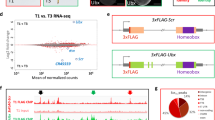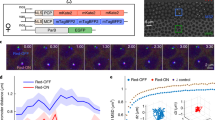Abstract
A MAJOR problem in the elucidation of the molecular mechanisms governing development is the distinction between direct and indirect regulatory interactions among developmental control genes1–5. In vivo studies have indicated that the Drosophila segmentation genefushi tarazu (ftz) directly or indirectly autoregulates its expression6. Here we describe a generally applicable experimental approach which establishes a direct in vivo interaction of the homeodomain protein ftz with the ftz cis-autoregulatory control region.In vitro studies have shown that the DNA-binding specificity of the ftz homeodomain can be changed by a single amino-acid substitution in the recognition helix (Gin 50 →"Lys)7. Whereas wild-type ftz homeodomain binds preferentially to a CCATTA motif, the mutant homeodomain (ftzQSOK) recognizes a GG ATT A motif. We now find that the in vivo activity of an ftz autoregulatory enhancer element is reduced by mutations of putative ftz-binding sites to GGATTA. This down-regulatory effect is specifically suppressed in vivo by the DNA-binding specificity mutantftzQ5OK. These results establish a direct positive autoregulatory feedback mechanism in the regulation of this homeobox gene.
Similar content being viewed by others
References
St Johnson, D. & Nüsslein-Volhard, C. Cell 68, 201–219 (1992).
Ingham, P. W. Nature 335, 25–34 (1988).
McGinnis, W. & Krumlauf, R. Cell 68, 283–302 (1992).
Affolter, M., Schier, A. & Gehring, W. J. Curr. Opinion Cell Biol. 2, 1485–1495 (1990).
Hayashi, S. & Scott, M. P. Cell 63, 883–894 (1990).
Hiromi, Y. & Gehring, W. J. Cell 50, 963–974 (1987).
Percival-Smith, A., Müller, M., Affolter, M. & Gehring, W. J. EMBO J. 9, 3967–3974 (1990).
Pick, L., Schier, A., Affolter, M., Schmidt-Glenewinkel, T. & Gehring, W. J. Genes Dev. 4, 1224–1239 (1990).
Hoey, T. & Levine, M. Nature 332, 858–861 (1988).
Desplan, C., Theis, J. & O'Farrell, P. H. Cell 54, 1081–1090 (1988).
Müller, M. et al. EMBO J. 7, 4299–4304 (1988).
Jarvik, J. & Botstein, D. Proc. natn. Acad. Sci. U.S.A. 72, 2738–2742 (1975).
Morris, N. R., Lai, M. H. & Oakley, C. E. Cell 14, 437–442 (1979).
Ebright, R. H. Meth. Enzym. 208, 620–640 (1991).
Hanes, S. D. & Brent, R. Cell 57, 1275–1283 (1989).
Hanes, S. D. & Brent, R. Science 251, 426–430 (1991).
Treisman, J., Gönczy, P., Vahishtha, M., Harris, E. & Desplan, C. Cell 59, 553–562 (1989).
Percival-Smith, A., Müller, M., Affolter, M. & Gehring, W. J. EMBO J. 11, 382 (1992).
Otting, G. et al. EMBO J. 9, 3085–3092 (1990).
Kissinger, C. R., Liu, B., Martin-Bianco, E., Kornberg, T. B. & Pabo, C. O. Cell 63, 579–590 (1990).
Driever, W. & Nüsslein-Volhard, C. Nature 337, 138–143 (1989).
Hiromi, Y., Kuriowa, A. & Gehring, W. J. Cell 43, 603–613 (1985).
Jaynes, J. B. & O'Farrell, P. H. Nature 336, 744–749 (1988).
Ohkuma, Y., Horikoshi, M., Roeder, R. G. & Desplan, C. Cell 61, 475–484 (1990).
Harrison, S. D. & Travers, A. A. Nucleic Acids Res. 16, 11403–11416 (1988).
Maier, D., Preiss, A. & Powell, J. R. EMBO J. 9, 3957–3966 (1990).
Spradling, A. C. & Rubin, G. M. Science 218, 341–347 (1982).
Saiki, R. K. et al. Science 239, 487–491 (1988).
Higuchi, R., Krummel, B. & Saiki, R. K. Nucleic Acids Res. 16, 7351–7367 (1988).
Hoch, M., Seifert, E. & Jäckle, H. EMBO J. 10, 2267–2278 (1991).
Author information
Authors and Affiliations
Rights and permissions
About this article
Cite this article
Schier, A., Gehring, W. Direct homeodomain–DNA interaction in the autoregulation of the fushi tarazu gene. Nature 356, 804–807 (1992). https://doi.org/10.1038/356804a0
Received:
Accepted:
Issue Date:
DOI: https://doi.org/10.1038/356804a0
- Springer Nature Limited
This article is cited by
-
Hox genes, evo-devo, and the case of the ftz gene
Chromosoma (2016)
-
Modulating Hox gene functions during animal body patterning
Nature Reviews Genetics (2005)
-
The nuclear hormone receptor Ftz-F1 is a cofactor for the Drosophila homeodomain protein Ftz
Nature (1997)
-
Patterning of the Drosophila embryo by a homeodomain-deleted Ftz polypeptide
Nature (1996)
-
Structure and regulation of the fushi tarazu gene from Drosophila hydei
Roux's Archives of Developmental Biology (1995)





